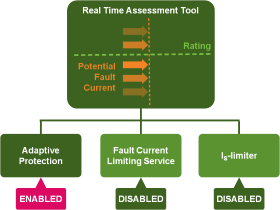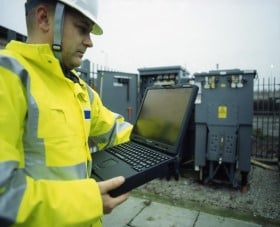Respond newsletter May 2016
Respond newsletter - May 2016
Our Low Carbon Networks (LCN) Fund project – ‘Respond’ – will deliver an intelligent approach to managing fault current – the instantaneous surge of energy which occurs under fault conditions. This is the third Respond newsletter and covers the go live of the project trials. We hope you find it of interest.
Technology

Fault Level Assessment Tool – Following a number of workshops, factory acceptance testing and site acceptance testing with our project partner Schneider Electric, the Fault Level Assessment Tool is now active and has been successfully integrated into our network management system.
This intelligent software uses network data to predict fault level in near real time. When fault level approaches or rises above our equipment ratings, the tool will “enable” or “disable” one of the three Respond fault level mitigation techniques: Adaptive Protection, the IS-limiter or the Fault Current Limiting service.
Adaptive Protection – Also known as sequential tripping, Adaptive Protection re-sequences the operation of circuit breakers. The Adaptive Protection installations can be retro-fitted and cover five 11kV and two 33kV substations. We have designed the Adaptive Protection installations to ensure they are easily translated to other DNOs as a standalone retrofit unit.
IS-limiter – This current-limiting fuse detects the rapid rise in current when a fault occurs and responds within 1/200th of a second to break the current. The IS-limiters have been through a number of factory acceptance testing stages during construction and have now been installed at two substation sites.
Trials & analysis

Post-fault monitoring and analysis procedure – During the project trials we need to validate every fault that occurs and ensure that the Respond installations have operated correctly.
We have produced a post fault analysis methodology which details the process and data requirements to confirm: fault level, operation of each of the respective fault level mitigation techniques and Fault Level Assessment Tool action.
Asset health study – We have developed an asset condition monitoring site selection and equipment rotation programme with EA Technologyand installed the equipment at a number of selected sites.
Fault level monitors – Outram fault level monitors have been installed at seven Respond sites. These monitors will validate our network model and the Fault Level Assessment Tool.
Fault Current Limiting Service

Our third technique, the Fault Current Limiting service (FCL service), is a commercial solution which provides a unique opportunity for large demand and generation customers to earn rewards by selling a fault current limiting response to us through a managed service agreement.
When a fault occurs, all sources of generation connected to the electricity network contribute to fault current. Using the Fault Level Assessment Tool and other new technology which will be trialled as part of the Respond project, we can turn off a customer’s motor or generation source for a few minutes, so that it no longer contributes to the fault current.
We are now seeking up to five large industrial business customers, with operations in the North West, to trial the FCL service.
Provisional negotiations with suitable customers in our operating area will start in May 2016. Organisations that are able and willing to trial the FCL service will then enter into a managed agreement with us for a term of 12 months.
Customer engagement

We have carried out an extensive customer engagement programme to determine the willingness and ability of customers across different industrial and commercial (I&C) sectors to provide managed FCL services.
Our engagement activities included two customer focus groups with ten I&C customers to help develop our customer communications materials and our survey instrument.
After a robust, targeted campaign and the use of project partners to recruit suitable respondents, a total of 103 I&C demand and distributed generation customers across GB participated in the customer survey.
Interim analysis of survey responses has proved the hypothesis that the Respond method enables a market for the provision of an FCL service.
Overall, indicative take-up of the FCL service among the total market is relatively low. However, appetite is significantly higher among non-manufacturing customers and organisations able to constrain their motor or generator for up to ten minutes without this having any significant impact on their operation and/or it resulting in any loss of productivity. These customers represent the target market for the FCL service.
The findings from the survey helped us determine the price point for the provision of FCL services and shape our customer contracts.
Further details can be found in the Interim Customer Survey Report which is published on the Respond website.
What's next?

Over the next few months we will be focusing on the following key activities:
- Publish equipment specifications and installation reports for Adaptive Protection and the IS-limiter
- Publish the NMS interface and configuration specifications and commissioning reports
- Publish a summary of each fault event three months after each event
- Publish a report on validation of the Fault Level Assessment Tool
- Engage with customers who may be willing to trial the FCL service
- Continue to keep you informed on our progress using our website, advertorials, newsletters and webinars.
Find out more

- To find out more about the Respond survey and trial visit the Get involved page of our website.
- If you are interested in providing a Fault Current Limiting service to Electricity North West, please contact us.
- You can find project information and presentations about Respond on the Key documents page of our website. We also have a number of videos which provide an overview of the project and the FCL service.
- If you have a general enquiry about the Respond project: email us or phone us on 0800 195 4141.
- If you are interested in attending any of our seminars or knowledge sharing events please contact us.